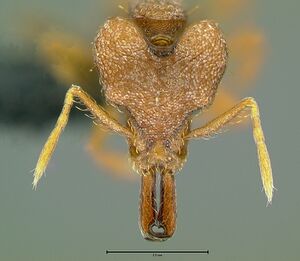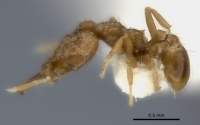Strumigenys koningsbergeri
| Strumigenys koningsbergeri | |
|---|---|

| |
| Scientific classification | |
| Kingdom: | Animalia |
| Phylum: | Arthropoda |
| Class: | Insecta |
| Order: | Hymenoptera |
| Family: | Formicidae |
| Subfamily: | Myrmicinae |
| Tribe: | Attini |
| Genus: | Strumigenys |
| Species: | S. koningsbergeri |
| Binomial name | |
| Strumigenys koningsbergeri Forel, 1905 | |
Known from wet forest litter-samples.
Identification
Bolton (2000) - A member of the koningsbergeri complex in the Strumigenys koningsbergeri-group. Of the nine species of the koningsbergeri-complex that lack pronotal standing hairs only one, Strumigenys offina, lacks humeral hairs and also lacks an erect pair on the mesonotum; all the other eight species have humeral and mesonotal hairs present. S. offina also has the width of the upper scrobe margin, immediately posterior to the frontal lobe, much greater than in any other species of the complex. In offina it is about equal to the maximum width of the scape; distinctly narrower than the scape in all the others.
Two of the species, Strumigenys seynoka and Strumigenys amasara, have hypertrophied femoral glands on the middle and hind legs; the hind leg gland bulla in these is 0.33-0.50 X the length of the femur. These dimensions are not approached by any other member of the complex, where the femoral gland bullae are very small or absent. The two separate easily as amasara lacks femoral gland bullae on the forelegs and has evenly convex upper scrobe margins. In seynoka a large bulla occurs on the foreleg and the upper scrobe margin is flared outwards at nearly a right-angle in the vicinity of the eye.
Following the separation of the above species koningsbergeri is easily isolated. It has a strangely shaped head, reminiscent of the loriae-group, with very irregular dorsolateral margin that allow the preocular impression and all of the eye to be seen in full-face view. Also, the transverse impression across the posterior vertex is better developed in koningsbergeri, being broader and deeper here than in any other species of the complex.
Of the remaining five species two (Strumigenys blanda, Strumigenys perturba) are large, with the combined range of cephalic dimensions HL 0.81-0.96, HW 0.69-0.82. The final three species (Strumigenys ignota, Strumigenys vertigosa, Strumigenys strygax) average smaller, with the combined range HL 0.64-0.83, HW 0.54-0.71. The slight overlap between the bottom of the former range and the top of the latter is accounted for by a few large individuals of ignota. These can be distinguished from both blanda and perturba as the edges of the upper scrobe margins in ignota workers have a decidedly jagged appearance, bearing a row of conspicuously projecting small triangular teeth, from the apex of each of which a small curved hair arises. In the other two species the hairs may arise from minute irregular elevation s, but the margin does not appear toothed and is not jagged.
S. penurba and blanda are very closely related. The former has small but distinct oval gland bullae present near the dorsal apices of the middle and hind femora; the propodeal lamella is broad and in profile has a convex posterior (free) margin. In blanda femoral gland bullae are absent and the propodeal lamella is very narrow in profile and has a concave posterior (free) margin that closely parallels the shape of the edge of the declivity.
Among the final three species only ignota has visible gland bullae on the hind femora, absent in Strumigenys vertigosa and Strumigenys strygax. The last two species are separated mainly by differences of sculpture and relative dimensions, as detailed in the key, but also the outline shape of the propodeum is subtly different between the two. With the alitrunk in profile the propodeal dorsum in strygax slopes upward from the metanotal groove then downward toward the propodeal teeth, forming a marked obtusely angular hump in the outline of the anterior half of the sclerite. In venigosa the propodeal dorsum curves shallowly and more or less evenly from the metanotal groove so that there is no marked hump in the outline.
Keys including this Species
Distribution
Latitudinal Distribution Pattern
Latitudinal Range: 6.734778° to -6.587°.
| North Temperate |
North Subtropical |
Tropical | South Subtropical |
South Temperate |
- Source: AntMaps
Distribution based on Regional Taxon Lists
Indo-Australian Region: Borneo, Brunei Darussalam, Indonesia (type locality), Malaysia, Philippines, Singapore.
Distribution based on AntMaps
Distribution based on AntWeb specimens
Check data from AntWeb
Countries Occupied
| Number of countries occupied by this species based on AntWiki Regional Taxon Lists. In general, fewer countries occupied indicates a narrower range, while more countries indicates a more widespread species. |

|
Estimated Abundance
| Relative abundance based on number of AntMaps records per species (this species within the purple bar). Fewer records (to the left) indicates a less abundant/encountered species while more records (to the right) indicates more abundant/encountered species. |

|
Biology
|
Castes
Worker
  
| |
| . | Owned by Museum of Comparative Zoology. |
Nomenclature
The following information is derived from Barry Bolton's Online Catalogue of the Ants of the World.
- koningsbergeri. Strumigenys koningsbergeri Forel, 1905c: 9 (w.q.) INDONESIA (Java). See also: Bolton, 2000: 846.
Unless otherwise noted the text for the remainder of this section is reported from the publication that includes the original description.
Description
Worker
Bolton (2000) - TL 2.5-3.0, HL 0.72-0.94, HW 0.61-0.86, CI 85-92, ML 0.32-0.42, MI 42-48, SL 0.39-0.47, SI 54-64, PW 0.29-0.36, AL 0.65-0.78 (20 measured).
With characters of koningsbergeri-complex. Preocular concavity extends onto ventral surface of head as a broad and deep transverse impression that almost reaches the midline. Dorsolateral margins of head weakly sinuate and subparallel from frontal lobes to about level of preocular impression, shallowly concave immediately above preocular impression, flared outward at nearly a right-angle just behind level of eye so that eye and preocular impression are visible in full-face view. Upper scrobe margins irregular but not jagged. Cephalic dorsum traversed from side to side by broad depression across posterior vertex. Pronotum without a pair of short standing hairs close to anterodorsal margin. Mesonotum with a single pair of erect hairs. Pleurae and side of propodeu m mostly to entirely unsculptured. Bullae of femoral glands vestigial or more commonly absent from middle and hind legs. Lamella on propodeal declivity conspicuous. Standing hairs on first gastral tergite simple or weakly flattened and expanded toward the apex.
Type Material
Bolton (2000) - Syntype workers and queens, INDONESIA: Java, Bogor ( = Buitenzorg), Tjompea, 1904 (K. Kraepelin) (Musee d'Histoire Naturelle Genève) [examined].
References
- Bolton, B. 2000. The ant tribe Dacetini. Memoirs of the American Entomological Institute. 65:1-1028. (page 846, figs. 443, 486, 501 redescription of worker)
- Emery, C. 1924f [1922]. Hymenoptera. Fam. Formicidae. Subfam. Myrmicinae. [concl.]. Genera Insectorum 174C: 207-397 (page 321, catalogue)
- Forel, A. 1905f. Ameisen aus Java. Gesammelt von Prof. Karl Kraepelin 1904. Mitteilungen aus dem Naturhistorischen Museum in Hamburg 22: 1-26. (page 9, worker, queen described)
- General, D.E.M. 2021. A preliminary checklist of the ants (Hymenoptera: Formicidae) of the Mt. Pantaron Range, Bukidnon Province, Mindanao Island, Philippines. Halteres, 12:4-14 (doi:10.5281/ZENODO.5371745).
- General, D.E.M., Buenavente, P.A.C., Rodriguez, L.J.V. 2020. A preliminary survey of nocturnal ants, with novel modifications for collecting nocturnal arboreal ants. Halteres 11: 1-12 (doi:10.5281/ZENODO.3707151).
- Herwina H., Sakamaki Y., Satria R., Janra, M.N. 2020. Ground-dwelling ants species diversity (Hymenoptera: Formicidae) at conservation forest and oil-palm plantation in Sumatra, Indonesia. Journal of Entomological Research 44(1): 113–120 (doi:10.5958/0974-4576.2020.00021.3).
- Musfira, S.H., Rafi, M., Gusti, M., Putri, D.H., Satria, R. 2022. New data on the genus Strumigenys (Hymenoptera: Formicidae) from Sumatra. Zoosystematica Rossica 31(1): 74–86 (doi:10.31610/zsr/2022.31.1.74).
- Philpott, S.M., Bichier, P., Rice, R.A., Greenberg, R. 2008. Biodiversity conservation, yield, and alternative products in coffee agroecosystems in Sumatra, Indonesia. Biodiversity and Conservation, 17: 1805–1820 (doi:10.1007/s10531-007-9267-2).
- Tang, K. L., Guénard, B. 2023. Further additions to the knowledge of Strumigenys (Formicidae: Myrmicinae) within South East Asia, with the descriptions of 20 new species. European Journal of Taxonomy 907, 1–144 (doi:10.5852/ejt.2023.907.2327).
- Wang, W.Y., Soh, E.J.Y., Yong, G.W.J., Wong, M.K.L., Benoit Guénard, Economo, E.P., Yamane, S. 2022. Remarkable diversity in a little red dot: a comprehensive checklist of known ant species in Singapore (Hymenoptera: Formicidae) with notes on ecology and taxonomy. Asian Myrmecology 15: e015006 (doi:10.20362/am.015006).
References based on Global Ant Biodiversity Informatics
- Bolton, B. 2000. The Ant Tribe Dacetini. Memoirs of the American Entomological Institute 65
- Chapman, J. W., and Capco, S. R. 1951. Check list of the ants (Hymenoptera: Formicidae) of Asia. Monogr. Inst. Sci. Technol. Manila 1: 1-327
- Forel A. 1905. Ameisen aus Java. Gesammelt von Prof. Karl Kraepelin 1904. Mitt. Naturhist. Mus. Hambg. 22: 1-26.
- Ito, F.; Yamane, S.; Eguchi, K.; Noerdjito, W. A.; Kahono, S.; Tsuji, K.; Ohkawara, K.; Yamauchi, K.; Nishida, T.; Nakamura, K. 2001. Ant species diversity in the Bogor Botanic Garden, West Java, Indonesia, with descriptions of two new species of the genus Leptanilla (Hymenoptera, Formicidae). Tropics 10:379-404.
- Kishimoto-Yamata K., F. Hyodo, M. Matsuoka, Y. Hashimoto, M. Kon, T. Ochi, S. Yamane, R. Ishii, and T. Itioka. 2012. Effects of remnant primary forests on ant and dung beetle species diversity in a secondary forest in Sarawak, Malaysia. Journal of Insect Conservation DOI 10.1007/s10841-012-9544-6
- Mezger D., and M. Pfeiffer. 2011. Partitioning the impact of abiotic factors and spatial patterns on species richness and community structure of ground ant assemblages in four Bornean rainforests. Ecography 34: 39-48.
- Mezger D., and M. Pfeiffer. 2011. Partitioning the impact of abiotic factors and spatial patterns on species richness and community structure of ground assemblages in four Bornean rainforest. Ecography 34: 39-48.
- Pfeiffer M., and D. Mezger. 2012. Biodiversity Assessment in Incomplete Inventories: Leaf Litter Ant Communities in Several Types of Bornean Rain Forest. PLoS ONE 7(7): e40729. doi:10.1371/journal.pone.0040820
- Pfeiffer M., and D. Mezger. 2012. Biodiversity Assessment in Incomplete Inventories: Leaf Litter Ant Communities in Several Types of Bornean Rain Forest. PLoS ONE 7(7): e40729. doi:10.1371/journal.pone.0040900
- Pfeiffer M.; Mezger, D.; Hosoishi, S.; Bakhtiar, E. Y.; Kohout, R. J. 2011. The Formicidae of Borneo (Insecta: Hymenoptera): a preliminary species list. Asian Myrmecology 4:9-58
- Philpott S.M., P. Bichier, R.A. Rice, and R. Greenberg. 2008. Biodiversity conservation, yield, and alternative products in coffee agroecosystems in Sumatra, Indonesia. Biodivers. Conserv. 17: 1805-1820. Data obtained from Stacy Philpott

